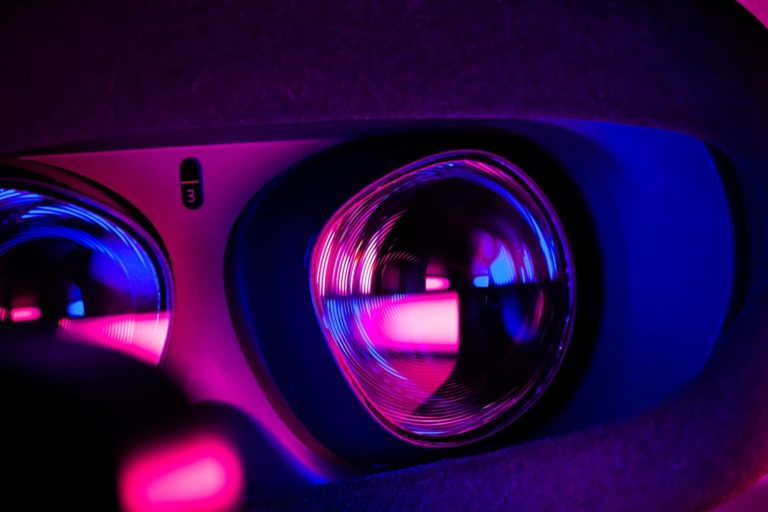
We recently speculated what Meta’s next generation of its Ray-Ban smartglasses – the third in line – could be and do. Now we take that forward-looking analysis to Meta’s other XR hardware line: Quest.
Though Quest 3 and 3s recently launched, Meta is already hard at work on Quest 4, given the length of these product development cycles. And from what we can see so far, it may redefine VR through upgrades to eye and face tracking. Its prototype – known as Project Pismo, which we’ll explore shortly – introduces cutting-edge tracking that could make VR experiences more realistic than ever before. By focusing on capturing facial and eye movements, Quest 4 could change how users interact within virtual spaces.
Project Pismo: What Is New in Tracking Tech?
Recent reports indicate that Meta is actively testing this prototype under the codename “Project Pismo”. It will incorporate sensors to capture users’ facial expressions and eye movements more precisely.
Enhanced tracking allows users to experience more immersive VR play by assessing emotions and gaze. These improvements will create more natural social interactions and elevate the realism of VR applications. While the technical specifics are under wraps, the advanced tracking is a step up from the previous models, creating a more lifelike experience.
The State of VR Tracking Today
VR tracking has quickly advanced in recent years, with companies like Meta, HTC and Sony leading in hardware and software development. Today, most mainstream VR headsets have basic tracking for following head and hand movements. However, advanced eye and face tracking are still emerging technologies that can create a lifelike interaction that many devices lack.
The standard VR includes external cameras, sensors, and controllers to capture a user’s body movements. For example, Meta’s latest consumer model, Quest 3, offers spatial tracking, using onboard cameras to map physical spaces and capture movement. Yet, current models remain limited when it comes to understanding finer facial expressions or precise eye movement. This restricts the depth of social VR interactions and keeps the system from responding naturally to the user’s gaze and emotional cues.
How Quest 4 Could Change VR Experiences
Meta’s Quest 4 promises to improve immersion by pushing the boundaries of tracking technology. Meta’s focus on integrating electromyography (EMG) technology is the most exciting potential advancement, as seen in its Meta Orion smart glasses.
The EMG band interprets neural signals in the arm to allow for gesture-based controls, which enhance user input by providing an alternative to hand tracking. While it allows for a more accurate experience, it also bypasses many of the limitations of traditional controllers. Instead, it enables subtle gestures to control VR interactions seamlessly. If Meta includes a neural band with the Quest 4, this could change how users interact within VR by enabling finer gesture controls.
The Quest 4’s eye tracking could also allow for more realistic interactions. For instance, users could make eye contact with another avatar. In gaming and professional applications, eye tracking could streamline user interface inputs so users can navigate menus or highlight objects by looking at them.
Moreover, these tracking improvements could achieve dynamic foveated renderings, where the headset focuses processing power on the user’s line of sight. This enhancement would boost visual fidelity while enhancing battery life. While implementing these tracking technologies is challenging, they will become the new standard for Quest headsets.
Use Cases of Advanced Tracking Technology
VR has opened a world of applications beyond entertainment — many fields use advanced tracking to boost how you learn, train and perform.
1. Enhancing Aviation Training and Safety
Safety is critical in aviation, so companies use tracking technology in training. Eye tracking can improve flight safety by creating simulations for a more realistic experience.
By monitoring a trainee’s gaze, these systems can ensure the instruments and displays receive adequate attention, reinforcing monitoring habits. Since over 70% of aviation accidents occur from human error, eye tracking can reduce these risks.
2. Improving Education Through Engagement
Tracking technologies improve learning by enhancing student engagement. Research shows that engaging students in learning can increase focus and attention, leading to better retention and comprehension.
With eye tracking integrated into VR, educators can create immersive experiences that monitor where students are looking, identifying areas of focus and distraction. By understanding student engagement more deeply, instructors can adapt content dynamically to capture attention where needed. This real-time responsiveness promotes an active learning environment where students stay focused and achieve greater academic outcomes.
3. Revolutionizing Sports Training and Performance
Eye tracking is creating new avenues in sports. It can analyze an athlete’s visual attention when VR systems create gaze-controlled scenarios that guide the users to key points of movement or action.
For instance, a virtual handball training module could feature a thrower and a goalkeeper to allow the goalkeeper to anticipate the ball’s trajectory and refine gaze behavior. This interaction helps athletes develop predictive skills and improve reaction times by directing their attention to critical cues during gameplay.
The Future of Eye and Face Tracking in VR
VR tracking technology looks promising in the near future. Companies are developing tools to aggregate and translate eye-tracking data using artificial intelligence (AI) and machine learning. These tools aim to correlate data from various tracking systems, allowing VR platforms to deliver smoother user experiences. This data aggregation could enable VR applications to interpret users’ focus, engagement levels and emotional states to create real-time adaptive experiences.
Researchers are also exploring what causes cybersickness, a challenge that limits VR usage. By studying eye movement, posture and physiological responses, experts hope to identify triggers for cybersickness and develop ways to make VR more comfortable for extended periods. This research may ultimately lead to more personalized VR experiences where the device adjusts its settings based on individual tolerance levels.
Shaping Immersive Experiences With Quest 4
Meta’s Quest 4 is a bold step forward in VR tracking technology. With these advancements, VR can deliver more realistic interactions and finely tuned gaming experiences. As tracking technology increases in precision and AI-driven tech, you will likely see VR environments respond more intuitively to your actions and emotions.
 Eleanor Hecks is Editor-in-Chief of Designerly Magazine where she specializes in design, development and UX topics. Follow Designerly on X @Designerlymag.
Eleanor Hecks is Editor-in-Chief of Designerly Magazine where she specializes in design, development and UX topics. Follow Designerly on X @Designerlymag.

